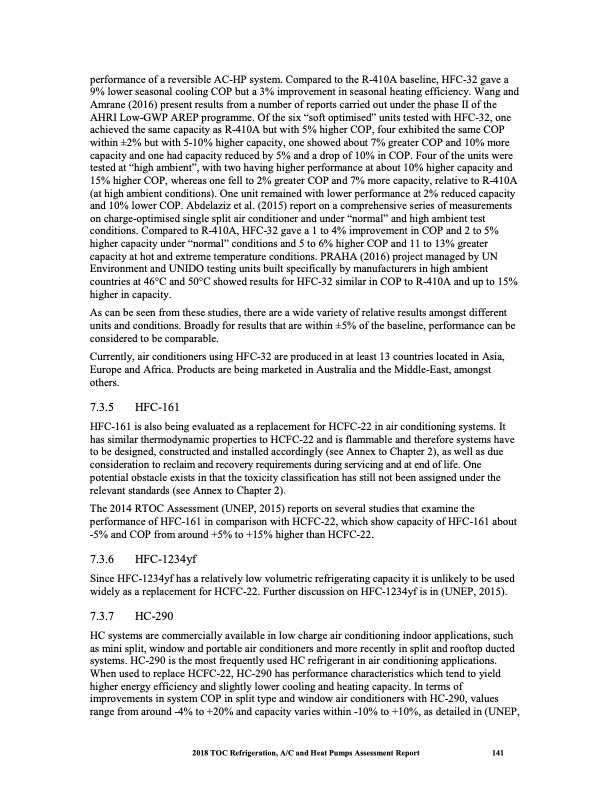
PDF Publication Title:
Text from PDF Page: 154
performance of a reversible AC-HP system. Compared to the R-410A baseline, HFC-32 gave a 9% lower seasonal cooling COP but a 3% improvement in seasonal heating efficiency. Wang and Amrane (2016) present results from a number of reports carried out under the phase II of the AHRI Low-GWP AREP programme. Of the six “soft optimised” units tested with HFC-32, one achieved the same capacity as R-410A but with 5% higher COP, four exhibited the same COP within ±2% but with 5-10% higher capacity, one showed about 7% greater COP and 10% more capacity and one had capacity reduced by 5% and a drop of 10% in COP. Four of the units were tested at “high ambient”, with two having higher performance at about 10% higher capacity and 15% higher COP, whereas one fell to 2% greater COP and 7% more capacity, relative to R-410A (at high ambient conditions). One unit remained with lower performance at 2% reduced capacity and 10% lower COP. Abdelaziz et al. (2015) report on a comprehensive series of measurements on charge-optimised single split air conditioner and under “normal” and high ambient test conditions. Compared to R-410A, HFC-32 gave a 1 to 4% improvement in COP and 2 to 5% higher capacity under “normal” conditions and 5 to 6% higher COP and 11 to 13% greater capacity at hot and extreme temperature conditions. PRAHA (2016) project managed by UN Environment and UNIDO testing units built specifically by manufacturers in high ambient countries at 46°C and 50°C showed results for HFC-32 similar in COP to R-410A and up to 15% higher in capacity. As can be seen from these studies, there are a wide variety of relative results amongst different units and conditions. Broadly for results that are within ±5% of the baseline, performance can be considered to be comparable. Currently, air conditioners using HFC-32 are produced in at least 13 countries located in Asia, Europe and Africa. Products are being marketed in Australia and the Middle-East, amongst others. 7.3.5 HFC-161 HFC-161 is also being evaluated as a replacement for HCFC-22 in air conditioning systems. It has similar thermodynamic properties to HCFC-22 and is flammable and therefore systems have to be designed, constructed and installed accordingly (see Annex to Chapter 2), as well as due consideration to reclaim and recovery requirements during servicing and at end of life. One potential obstacle exists in that the toxicity classification has still not been assigned under the relevant standards (see Annex to Chapter 2). The 2014 RTOC Assessment (UNEP, 2015) reports on several studies that examine the performance of HFC-161 in comparison with HCFC-22, which show capacity of HFC-161 about -5% and COP from around +5% to +15% higher than HCFC-22. 7.3.6 HFC-1234yf Since HFC-1234yf has a relatively low volumetric refrigerating capacity it is unlikely to be used widely as a replacement for HCFC-22. Further discussion on HFC-1234yf is in (UNEP, 2015). 7.3.7 HC-290 HC systems are commercially available in low charge air conditioning indoor applications, such as mini split, window and portable air conditioners and more recently in split and rooftop ducted systems. HC-290 is the most frequently used HC refrigerant in air conditioning applications. When used to replace HCFC-22, HC-290 has performance characteristics which tend to yield higher energy efficiency and slightly lower cooling and heating capacity. In terms of improvements in system COP in split type and window air conditioners with HC-290, values range from around -4% to +20% and capacity varies within -10% to +10%, as detailed in (UNEP, 2018 TOC Refrigeration, A/C and Heat Pumps Assessment Report 141PDF Image | Heat Pumps Technical Options

PDF Search Title:
Heat Pumps Technical OptionsOriginal File Name Searched:
RTOC-assessment-report-2018_0.pdfDIY PDF Search: Google It | Yahoo | Bing
CO2 Organic Rankine Cycle Experimenter Platform The supercritical CO2 phase change system is both a heat pump and organic rankine cycle which can be used for those purposes and as a supercritical extractor for advanced subcritical and supercritical extraction technology. Uses include producing nanoparticles, precious metal CO2 extraction, lithium battery recycling, and other applications... More Info
Heat Pumps CO2 ORC Heat Pump System Platform More Info
| CONTACT TEL: 608-238-6001 Email: greg@infinityturbine.com | RSS | AMP |